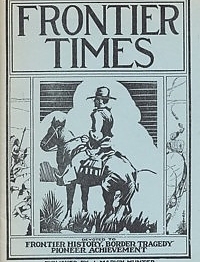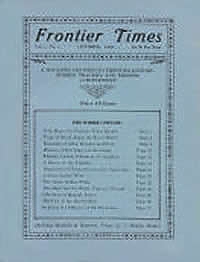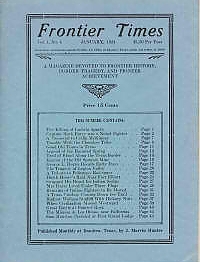By using our website, you agree to the use of cookies as described in our Cookie Policy
Magazines & Instant Downloads
Vol 11 No. 09 - June 1934
The Texas Petroleum Industry
It was in 1895 that the American Well and Prospecting company, contractors, while sinking a well for water at Corsicana, discovered oil at a depth of about 1000 feet, which started the petroleum development in Texas. This is a great article on the earliest development of the great oil industry in TX. Further Mentions: some heavy oil developed in Nacogdoches county, later abandoned, Major James E. Whitesall of Corsicana, J. S. Cullinan of Washington, Pa., came to Texas in October, 1897, to investigate, a group of men consisting of Senator Roger Q. Mills, Fred Pleming, Dr. Johnson, John Gibson and others owning producing wells, under which, they agreed to furnish 150,000 barrels of oil at a price of 50 cents per barrel, American Republics corporation, Petroleum Refining Company of Texas, later the Galena-Signal Oil company of Pennsylvania, Petroleum Iron Works company of Ohio, Craig F. Cullinan, son of J. S. Cullinan, Conroe, Hull, Barbers Hill Arriola district, Hardin county., Federal Petroleum Company, Pueblo Oil Company, Admiral Mellville, Calvin N. Payne of Titusville, Pa. Henry C. Folger, Waters Pierce Oil company, On January 10, 1901, the Captain Lucas well, drilling for salt at Spindletop, near Beaumont, Texas, blew in as the world's largest producer, creating a new epoch in petroleum history. Curt Hamill, With Spindletop production, Texas' output of petroleum jumped from 836,039 barrels in 1900 to 4,393,658 in 1901, Sindletop reached its peak, with production of 17,421,000 barrels, or 96 per cent of Texas' production for the year. In 1900 W. T. Waggoner, owner-of a 600,000-acre ranch in Clay and Wichita counties, gave orders to drill some deep water wells and in which showings of oil were developed, later leased to the Producers Oil company, who in 1911 developed oil in what has since been known as the Electra field (named for a daughter of Mr. Waggoner). This -was the first large field in North Texas, bringing Texas, production up to more than 15,000,000 barrels in 1913 and 20,000,000 in 1914. In the meantime the gulf coast area production had been strengthened by the opening of the Orange county f ield in 1913. discoveries at Moran and Strawn in 1914, followed by Ranger in 1917 and Burkburnett in 1918. the J. B. Stevenson lease at Humble, Texas. The Desdemona field in the Ranger area, etc, etc. TRULY EXCELLENT ARTICLE ON THIS SUBJECT – RICH IN DETAILS
An Early Day Experience
As told by Mrs. John Clementson, formerly Mrs. Coffin, to Miss Ruth Dodson, Mathis. Texas. When an innocent serenade nearly turned tragic. Mentions: Tom Mathis, Win. Coffin,
"Fifty-eight Years in Texas"
C. M. Grady, Brownwood, Texas. Very lengthy and detailed recollection of eye-witness events of pioneer life in central TX . Life as a TX Ranger, Indian fighting, buffalo hunts, bear hunts, etc, etc, Further Mentions: The Cheatham family, M. R. Cheatham, Clear Creek. Mexican Joe, In January, 1875, 1 went on my first buffalo hunt. There were five of us in the party, Tom Clark, Jake Carter, my brothers, Jack Grady, Will Grady, a stripling youth of 15 years, and I. We had a two horse wagon, and also a wagon drawn by an ox team, two lead horses, four long eared hounds, and two grayhounds. We took the old Fort Concho and Brownwood road, west to East Mukewater, straight on to Santa Anna Mountains, making our own road over ditches, hills, cat-claws, and rocks. It surely was rough getting across the little creeks. Our dogs dug up a family of coons on West Mukewater Creek. We killed five of them. As we neared the Santa Anna Mountains we saw a…" Tom Clark, Hay Creek, Bead Mountain near where Valera now stands, Post Oak Springs. Lost Creek, the Talpa country. Mr. Carter, Mustang Creek, Elm and Rough Creek, Moro Mountain, Jack Maltby, Rangers Company E, Church Mountains, Table Mountains, Brady Mountains, Fort Griffin, Mustang Gap to Wild Horse Flat, where Bangs is today. Brushy Mountain, Watt's Creek, on to the Jim Ned, the Kin Elkins ranch, Hoard's Creek, Buffalo Gap,, the Clear Fork of the Brazos, Phlantora Hill, Paint Springs, Double Mountain Fork of the Brazos; Signal Mosntains, the Blue Mountains on the upper Colorado. Old Paint Rock, Champion Creek, Captain B. Foster, Peter Avery, Maltby's Coinpany, Gray Eagle, Sergeant Andy Mather, Coporal Harry Sackett, Bill Willliams, Sergeant Arnett, Henry and Bill Dunman, Henry Thomas, Curly Hatcher, Bill St. Clair, Valley Creek, which is now in Runnels county, the Williams family, the Blaylock and Johnson families, also a Mr. Tom Milligan of Mason county, Miss Todd from Mason county. Curly Hatcher, Bill Williams, Caddo Peaks in Callahan county, Robertson's Peak north of Coleman, Tecumseh Peak, Cedar Prong of Mud Creek towards the Brushy Mountain, John and Will Hampton of Burnet county, Steppes Creek in Brown county, Bailey Barton, who lives on Home Creek, Camp Blair on Pecan Bayou, Shorty Brown and his two nephews named Norton, Fort Chadbourne. Captain Foster, Bald Eagle Mountain, Double Mountain Fork, Clark Fork and Salt Fork; Sweetwater, Paint, Bitter, Oroton creeks, Joe Seay, Lieutenant George Arrington, Mrs. Dudley Johnson, Lieutenant Mose Israel, and Bill Lorance., Jep Brown, Harry Sackett, W. B. Anglin, settlers, Staffords, St. Clairs, Hardins, Livingstons, and Robertsons, "I will say after all my scattering thoughts that old Santa Anna Mountain is very dear to me. Through all my forty years of residence in Coleman county, I was always in sight of this grand old signal post of my Ranger days. Many times it was obscured by hovering clouds, but when they rolled away, the beautiful sunset would come, painting its halo with colors more vivid than the rainbow. There it has always stood, secure in its silent grandeur, beloved by all within sight of it. On the east end of the East Mountain I carved my initials with the date, " C. A. G. 1875, " and it can still be read to this day. Captain B. Foster's name is cut on the same rock."
Many Notables Attended Gonzales College
By Leo Wallace. Great account of the pioneer settlement of Gonzales on the bank of the Guadalupe River which exerted very notable influence in statesmanship and education over the State, as later developments have shown. This could not, have been more than a fond hope and trust in the hearts -of those devoted and stalwart parents who founded, way back about 1851, "Old Gonzales College." This article gives much interesting and helpful genealogical and historical data available nowhere else.
Further Mentions: Four land certificates were deeded to D. Al. Oliver and A. W. Hill in January of 1852 and four more sold to Felix Chanault in February of 1853. The proceeds of these sales went into the college funds. Gonzales College was built of stone, hauled by ox-earts from Peach Creek quarry some 10 miles east, man named Mooney doing the work. For the next 10 years, the Gonzales College stood at the head of the State's few educational institutions, headed by such eminent educators as David B. Edwards and Thomas J. Pilgrim. Prof. David B. Edwards, a man of Scotch descent, and a widely traveled and highly educated man, was the first teacher in Gonzales -- pioneer families, the Zumwalts, Cottles, Lockharts, Davis, McCoys, DeWitts, Darsts and others, pursued their training under this grand and capable leader. the names of Pilgrim, Stewart, Darst, . H. B. Nichols, A. M., president and professor of languages and natural sciences; H. L. Nichols, professor of mathematics, and assistant in languages and natural sciences. Demund Heinemann, professor of instrumental music. Buckner Harris, tutor. Mrs. Mary Hill, prineipal of the female department, Miss Sarah Weir, assistant." Arithmetic, English, grammar, geography, Greek, Latin, French, German and Spanish, music… Uncle Billie" Atkinson, the "Gonzales Rifles," and later in the spring the "Gonzales Rebels," two mounted voluntary fighting units, among those names were represented the families of the Jones' (Isham G. Jones was captain), Badger, Parramore, Dillworth, Mason, Tate, Chanault, Brooks, Zumwalt, DeWitt, Nash, Hampton and many others. Professor Brooks, Professor H. M. Allis, principal, The class was composed of nine graduates: Katherine Clark, Luxima Collins (later Mrs. F. G. Smith), Thankful McClure, Mattie Price, Mary Kaufmann, Minerva DeWitt, Tom Gilmore, Otho Hill and Mannie Mitchell. Captain Bass, Professor Allis. H. M. Allis, William H. Stewart, C. S. Brown, Eli Mitchell and J. B. Patrick., The minutes under date of February 26, '72, contains the following action: "A motion was carried that Gonzales Lodge No. 38, I. O. O. F., take one scholarship in the Masonic and Odd Fellows College." Also, "Moved that Bros. Knox, Peck and Burchard be elected as directors to confer with directors elected from Masonic bodies." Stephen F. Darden, a; charter member of the Gonzales Masonic lodge, David S. H. Darst and William A. Matthews, James F. Miller, Judge B. R. Abernethy and W. M. Fly, all grand masters of the Masonic order and graduates of the college. Also Henry. L. Qualls, member of both orders. George W. L. Fly, R. Lewis, Mrs. Mary C. Hill, teachers, Misses Lamkin and Fannin., the marriage of Edd Scheske to Miss Jessie Smead,, Mrs. Henry Reese Jr., Judge W. M. Atkinson, a graduate of the college, David B. Edwards, first teacher in Gonzales, to Major George W. L. Fly, probably the last, in the college, Hon, T. F. Harwood, Miss Ora Wood and Miss Laura Reese, sister of Henry Reese Jr., deceased editor and publisher of the Inquirer. Judge John S. Conway, whose name needs but to be mentioned in Texas, Sam H. Hopkins, father of Senator Hopkins of Gonzales, Joe and R. M. Hall, Presbyterian minister of fame, Mrs. W. J. Hildebrand, etc, etc.
Comanche Springs at Fort Stockton are Improved
San Angelo Morning Times. (Includes old B&W image of old Koehler Store at Frt. Stockton). Early history and later preservation of the springs at Fort Stockton are described. Further Mentions: the James Rooney Memorial Park, Koehler's store, H. H. Butz, Rooney Mercantile Company., Leon Springs.
Lone Prairie
By John M. Hendrick, in Hoofs and Horns. Account of one of the most interesting of the old time cowmen, Mr. Luther T. Clark of Quanah, Texas, who spent the entire 80 years of his life as cowhand and cattle raiser, never having had any other vocation. The 68' years that he spent in the saddle covered cow work and cow business in every section of the state where cattle have been handled on a large scale. At some time or other, he has crossed the trail of, and passed the time of day with every cowman and trail boss of any prominence in Texas cattle history. Great account of early TX cattle business. Further Mentions: the prairies of Denton County, trail herds in Atascosa County, He was present at that memorable meeting at Graham, Young County, Texas, when the Texas Cattle Raisers Association was formed. His activities as ranch and cattle owner have covered the Cheyenne and Arapahoe Reservation, the Lost Valley of Young County, the Breaks of the Cap Rock country and the Great Staked Plains. 37,000 acre ranch on the north Concho, near Water Valley, Texas. This ranch is owned and operated by Mr. Clark and his son, L. C. Clark., the Dan Waggoner cattle. TOM CRYSTAL,
Paradise in Texas
Uvalde Leader News. Account of book written by Judge W. B. Lewis, who grew up in Panhandle and witnessed a civilization where he says all the people met on the same level and where poverty and misfortune were as much respected as title and wealth, where rich and poor met around the same "shack," did the same work and shared the same victuals-and every man was considered a gentleman until proven otherwise. There is no question but what West Texas was then a country, peculiar, to itself-where all traits of characters were sure to be tested-where four-flushers and shams could not long exist-a land of great hospitality, a land where everyone faced uncertainties of the West; dangers, hardships, as courageously as any hero of the battleships. Further Mentions: L. B. Carruthers, Victorio,
Death Ends Saga of Early Days in Wild Trans-Pecos
By H. T. Fletcher. Early in 1880, a band of outlaws, whose operations in New Mexico made them undesirable citizens there, drove a bunch of stolen cattle to Fort Stockton. They sold their herd to the post contractor and made the town their headquarters. The sheriff made an agreement with them that if they would not operate in Pecos County he would not molest them. Shortly after, the store of Sender & Seibenborn, at Fort Davis, was held up and looted, the bandit-, returning to their camp at Fort Stockton. Learning of the robbery, a posse of Fort Stockton citizens, headed by Francis Rooney, raided their camp and captured one of them, known as Charlie Davis, who was locked in the county jail, the others escaping. This account details the subsequent events that led up to the apprehension and death of these men and the unique way it was handled by the innovative Rangers.
Further Mentions: Governor Roberts, Sergeant Carruthers, Camp Swenson, Major John B. Jones of the Rangers, a two-gun gambler named John Gunter, Gunter was soon identified as John Selman, Captain Dan Roberts, Sergeant Ed Seiker, Charlie Davis, Sheriff T. A. Wilson, Rangers Red Bingham, Tom Carson, Dick Russell and Sam Henry, Cleto Herredio, Victoriano Hernandez ranch situated on Alamito Creek, Ranger Bingham and Outlaw George Davis, Richard Daly, justice of the peace at Presidio, Jesse Evans and John Gross, Bud and Charlie Graham,
Alamo's Flag Discovered in Mexican Museum
By B. C. Utecht. Account describes the discovery of the flag and provides a new chapter in Texas history, which reveals with what scorn some high Mexican officials at least condemned Santa Anna's tactics and disregard of civilized warfare. Further Mentions: W. A. Keeling, Luis Castrillo Ledon, Gen. D. Juan Torrea, the Jiminez battalion, Col. Juan Morales, the Zapadores battalion, General Torrea, himself a high and respected Mexican general, used about as harsh language against Santa Anna and the slaughter at the Alamo as has any Texan. D. K. Martin,
Ox Wagons, Indians, and Winchesters
Murter Neora Keel. Riveting eye-witness account of depravations and dangers on wagon train in 1850. The Keels continued on to California but later returned to finally settled down in Tarrant, Texas, An excerpt: Then occurred a most dreadful thing. In our train there was a young boy newly married, a know-it-all. No one could tell him anything. He swore he would kill the first Indian he saw. We came upon an old Indian squaw, white headed. Sure enough, this boy drew his pistol and shot her dead, everyone begging him not to. My father was 50 wagons ahead and did not even hear the report of the pistol. Father said he did not know the boy had such a weapon, or he would have taken it away from him. Three days afterwards they looked back and saw 150 warriors coming at break-neck speed. They never stopped -until they came to the three horsemen, my father, Dave and another man who was a preacher. They asked who killed the squaw. Neither of the three men knew. "If you do not tell us," they said, we'll massacre the whole train." Father halted the wagons, took the Indians back with him and the other two men. When they came to the fiftieth wagon, a little boy 10 years old spoke up and said the fellow who killed the squaw was in that wagon covered up with a feather bed. "Come out," demanded my father, 'and tell why you did this thing; if you do not, every one of us will be killed."
The boy came out and told them. His parents and his wife's parents tried to buy the Indians off, but no. They took him a short way from the wagon, hung him up feet foremost, and flayed (skinned) him alive.
They then told my father they could go, but not to touch that man. The whites had to do as the Indians said. It almost killed the young wife and the boy's mother and father. They lay for three days in such a condition that the others did not think they would or could live…" Further Mentions: Dave Doudle, Pecos River at Horsehead Crossing, Van B. Derrick, Miss Sidney,
A Blanco County Tragedy
By L. W. Kemp, Houston, Texas
WHEN BLANCO county was created February 12, 1858, from Burnet, Hays, Gillespie and Comal counties, the little town of Pittsburg, (named for General William A. Pitts, its founder) up until then in Comal county, was named as the county seat. Later surveys, however, showed it not to be the geographical center of the county, as then created, as the law of that time required, about a mile to the present town of Blanco. Pittsburg was abandoned, and today but few people have ever heard of it.
Near Pittsburg in 1865 the murder of two men and the lynching of two -others on practically the same spot stirred Texas from center to circumference. Not alone on account of the number of deaths or the spectacular manner in which they occurred, but mainly because of the prominence of one of the victims, James Hughes Callahan, for whom a county in Texas was later named.
Callahan, fearless and daring, spent most of his life after reaching Texas in 1835, in the defense of the Republic and the State. With Fannin at Coleto, he, through fate, had escaped the massac.re of Palm Sunday March 27, 1836. After the revolution he settled first at Gonzales and later at Seguin, where he made himself famous as a captain of minute men, volunteers who dropped their work at a minute's notice to defend the country against marauding bands of IndiaDs or Mexicans. At the time of his tragic death his spectacular fight with Indians whom he had followed across the Rio Grande into Mexico was still one of the principal topics
$4.95
‹ Back








